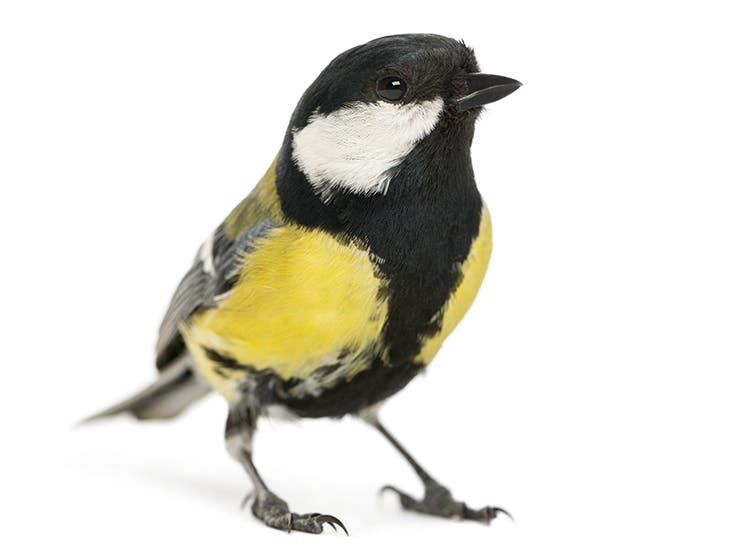There’s no doubt that the climate in many parts of the planet is changing quickly. The planet is getting hotter, sea levels are rising, storms are intensifying, many lands are drying up—and there are going to be more changes that will test organisms’ ability to adapt and survive. While many species on the planet are taking a hit, some are managing to put up a relatively good fight. We’re one. The great tit is another.
It’s got a ridiculous name, but the wild great tit, Parus major, needs to be taken seriously. A black-headed, yellow-bellied garden bird found all over Europe, the great tit is one of the most extensively studied species in the world. British and Dutch ornithologists, in particular, have been observing them for over 70 years. (In fact, these two breeds of great tit researchers debate over who’s been studying the tit longer.)
Scientists often use great tits because they’re abundant and adjust well in captivity. Many regard them as one of the most innovative avian species on the planet, due to their ability to devise new foraging strategies and also to learn these methods from one another. Being the clever “lab rats” of ornithology, great tits provide us with a window into how birds and other species, including us Homo sapiens, are coping with environmental challenges, especially when it comes to climate change. Yet biologists are stumped by the mechanisms that underlie the great tit’s inventiveness.
Answering this question begins with watching how great tits eat. They mostly gulp down caterpillars, but studies in recent years have shown that caterpillars have been popping out earlier in the spring because of warmer temperatures. This shift in timing would normally drag down the numbers of predators that eat them, but the great tit’s population has remained stable, according to a study published this past April in the journal Science. One of the ways that great tits deal with this is by laying their eggs earlier to coordinate with the caterpillars. According to Thomas Reed at the Netherlands Institute of Ecology, great tits can seemingly predict when the caterpillars will arrive. “The great tits take temperature-based cues, possibly through skin receptors or by other means, such as noticing the presence of leaves on trees,” said Dr. Reed. “But we don’t know what the mechanism is behind temperature-sensing.”
In April, another study published by the Netherlands Institute of Ecology explored the possible physiological components that allow birds to sense changes in temperature. It looked at patterns in hormones, such as melatonin, and brain structures that are involved in reproduction. But it found no clear answer.
Some researchers, like Lucy Aplin, a Ph.D. student at Oxford University, believe that social learning plays an important role in these situations. Aplin, who studies how great tits learn useful foraging behaviors from each other, thinks they could also be laying their eggs earlier from watching others do the same.
“The great tits take temperature-based cues, possibly through skin receptors or by other means. But we don’t know what the mechanism is behind temperature-sensing.”
One famous example of avian social learning occurred in 1921 at a town in southern England. Residents noticed that great tits and blue tits, a close relative, were treating themselves to breakfast by piercing through the foil caps of milk bottles to feed on the cream sitting on top. Eventually, people switched to screw-top lids, but the phenomenon piqued scientific curiosity.
Recently Aplin and her colleagues replicated the milk bottle phenomenon using blue tits to test the relationship between social learning and innovation in these birds. They first trained one bird to pierce through bottle caps and another bird to flip bottle lids to get at milk below, and then introduced those birds to two groups of naïve birds. About half of each group picked up the handy tricks. In the third group, they did not introduce any trained birds, and none of the birds figured out how to get to the cream.
While this demonstrates that social learning prevails among great tits, scientists still don’t know why this occurs and, moreover, what compels the great tits to explore the way they do. “What drives innovation? That’s the million-dollar question,” said Ms. Aplin.
Some researchers are looking for answers in the great tit’s genome. In 2007, scientists at the Max Planck Institute for Ornithology discovered that a gene, which codes for a variant of a dopamine receptor called DRD4, is linked a greater tendency for exploratory behavior among some populations of great tits. The DRD4 gene is also associated with novelty-seeking behaviors in humans.
Yet, even if we do solve the mystery of how great tits—and some other animals, like humans—devise clever ways to adapt to an uncertain future, how long can we count on this to help them survive? The ornithologists believe that for now, the great tits can adjust, but that whatever adaptive mechanisms they have may not be able to keep up with the rate that the environment is changing.
“Even if great tits are making the effort to adapt, we’re not saying that climate change won’t cause them problems,” said Reed. “The birds are just buying their time.”
Eli Chen is a freelance journalist based in Brooklyn who has contributed to The New York Times, Science Friday’s blog, and OnEarth magazine.



